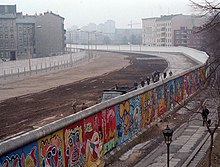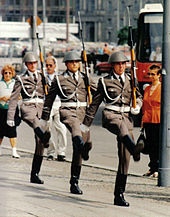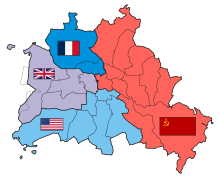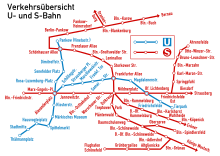East Berlin
| Basic data | |
|---|---|
| Administrative headquarters: | East Berlin |
| Flag : |

|
| Coat of arms : | |
| Area : | 403 km² |
| Residents : | 1,279,212 (1989) |
| License plate : | I. |
| map | |
East Berlin , also East Berlin or Berlin (East) , is a name for the part of Greater Berlin that formed the Soviet sector until 1990 after the occupation of the city by the victorious powers of World War II .
After the Red Army of the Soviet Union had conquered the entire area of Berlin after the Battle of Berlin , it withdrew from the western sectors constituted from it due to the resolutions of the Yalta Conference in the summer of 1945.
Geographically, East Berlin extended with minor deviations to the areas of today's districts Treptow-Köpenick , Marzahn-Hellersdorf , Lichtenberg , Pankow and the districts of Mitte and Friedrichshain .
In Western parlance, the term "East Berlin" also served to delimit the Soviet from the US, French and British sectors, which were collectively referred to as West Berlin . East Berlin was the administrative center of the Soviet Occupation Zone (SBZ) and later, after the GDR declaration, the capital of the German Democratic Republic . The term "East Berlin", however, had no official usage in either the old Federal Republic or the GDR.
The official name was changed over the years from Greater Berlin, Democratic Sector via Democratic Berlin (1946–1950) to Berlin, the capital of the GDR or Berlin . In official linguistic usage in the GDR until the 1970s, it became increasingly common to give only the western part of the city a separate name (West Berlin) , but to briefly refer to the eastern part as Berlin (see the chapter on conceptual problems ).
Under international law , the Soviet sector of Berlin was part of the four- sector city under the sovereignty of the four powers United States , Soviet Union, United Kingdom and France ; thus the eastern part of Berlin was never part of the Soviet occupation zone or the GDR, according to western opinion. The different views on the status of East Berlin were the subject of the Berlin question , but from the 1970s at the latest they were of little importance in practice.
history





Status issues
With the London Protocol of November 1944, the United States, the Soviet Union and the United Kingdom decided to divide Germany after the unconditional surrender into three zones of occupation and a "special Berlin area that is jointly occupied by the three powers." fourth power still France (together the Allies or Four Powers ). For the whole of Berlin, a government named Magistrat von Groß-Berlin ( Magistrat Werner ) was set up by the Soviet Union in May . On June 5, 1945, the Allies again determined the joint occupation of Berlin. The Allied Control Council began its work on July 11th . The Western Powers had proposed moving it to the former Reich Aviation Ministry on Leipziger Strasse , but the Soviet Military Administration in Germany (SMAD) prevented any four-power facilities in East Berlin from building. Instead, the German central administration for the Soviet occupation zone was housed on Leipziger Strasse, establishing close institutional ties with East Berlin. The SMAD also treated East Berlin and its zone economically as a unit, although traffic at the city limits was controlled until 1977.
The former eastern districts of Mitte , Prenzlauer Berg , Friedrichshain , Pankow , Weißensee , Lichtenberg , Treptow and Köpenick formed the Soviet sector of Greater Berlin from then on .
In June 1948 the Soviet representative left the Allied command and in the following months the joint administration of Berlin broke up. A separate city government was set up in the Soviet sector, but it continued to call itself the Magistrate of Greater Berlin , later also with the addition of the Democratic Sector.
According to Article 23 of the Basic Law (old version) , the Basic Law for the Federal Republic of Germany should also apply to a state of Greater Berlin . The Soviet Union, however, refused to apply the Basic Law to its sector of Berlin, and in the other sectors it could only develop a limited validity due to the reservation of the Western Allies.
In the Soviet occupation zone, on October 7, 1949 ( Republic Day ), the provisional People's Chamber for the states of Saxony , Saxony-Anhalt , Thuringia , Brandenburg and Mecklenburg enacted the all-German constitution of the German Democratic Republic and thus the German Democratic Republic Republic established. In Art. 2 of this constitution it was determined: “The capital of the republic is Berlin”, a reference to the originally hoped-for establishment of an all-German state.
Due to the city's four-power status, the Soviet sector of Berlin did not belong to the Soviet Zone and initially did not become a constituent part of the GDR. Their constitutional organs had no direct power there. Laws of the GDR came into effect there only indirectly after they were adopted by the magistrate. East Berlin could only send delegates with an advisory vote and without direct election to the legislative bodies of the GDR.
The ties to the GDR were very close from the start, if only for the fact that it took its seat of government in East Berlin and proclaimed the whole of Berlin as its capital. Nevertheless, both the government of the GDR and the SMAD ensured that Berlin's special status was formally maintained in order to be able to lay claim to governmental power over the whole of Berlin. For as early as 1948, contrary to the London Protocol, the Soviet Union had been of the opinion that the whole of Berlin would be part of the Soviet Zone, albeit under the joint administration of the Four Powers. In addition, there was the realization that the Berlin question could be an important point for a desired reunification. Out of consideration for the difficult international legal situation, the GDR initially only took cautious measures to integrate East Berlin more closely. Since October 1953, for example, GDR identity cards have also been issued in East Berlin .
From 1956 on, the fighting groups of the working class and the newly founded National People's Army (NVA) organized military parades in East Berlin. The ambassadors of the Western powers protested to their Soviet colleague because Control Council Act No. 43, which was still in force in Berlin, forbade Germans from carrying weapons. Ambassador Georgi Maximowitsch Pushkin referred them to the government of the GDR. The seat of the Ministry for National Defense of the GDR was established outside of Berlin (in Strausberg ) from the start.
In January 1957 an important step was taken in the integration of East Berlin into the GDR. The representatives of the people and the magistrate adopted the GDR laws on the local organs of state power and on the rights and obligations of the people's chamber towards the local representative bodies . As a result, the magistrate was subordinated to the Council of Ministers of the GDR and the People's Chamber was given the supervision of the East Berlin people's representation, which was renamed the City Council. At the same time, the dispute over the status of Berlin came to a head.
With the Khrushchev ultimatum (→ Berlin crisis ) on November 27, 1958, the Soviet Union demanded the transformation of West Berlin into a free city as a so-called special political unit. In this and another note from 1959, she stated that the London protocols of the victorious powers on the joint occupation of Berlin were no longer valid. The Western Allies rejected these ideas and insisted on the four-power status of all of Berlin.
With the construction of the Berlin Wall in 1961, the division of Berlin was cemented and further measures for the integration of East Berlin into the GDR soon followed. In September of the same year the State Council put East Berlin on an equal footing with the districts in the GDR .
The newly introduced conscription in the GDR in January 1962 also extended to the residents of East Berlin. In August 1962, the Soviet city command in East Berlin was dissolved and replaced by a city commandant from the NVA. In 1968, those eligible to vote in East Berlin also took part in the referendum on the new constitution of the GDR, which thus also had direct effect in the eastern sector of Berlin.
After lengthy negotiations, the Four Power Agreement on Berlin was signed in September 1971 , which, among other things, regulated the nature of West Berlin's links with the Federal Republic. As a result of the agreement, the conflict over Berlin visibly relaxed in the following period. The preamble and the general part of this treaty confirmed the four-power status for Berlin, but the formulations left room for interpretation: In the interpretation by the GDR and the Soviet Union, the provisions referred only to West Berlin. They no longer represented the claim to Berlin as a whole and saw East Berlin as an independent city and capital of the GDR. The Western powers, on the other hand, did not see the four-power status of Greater Berlin as affected, even though they recognized that East Berlin was the seat of the government of the GDR. After the establishment of diplomatic relations with the GDR in 1974, they therefore settled their embassies there and not, as had been considered in the meantime, in Potsdam . The still existing Western legal opinion that East Berlin was not an “integral part of the GDR” was satisfied by the fact that the embassies were officially called “to the GDR” and not, as is usually the case, “in Berlin”. This legal opinion was the reason that state visits by Federal Chancellors in the GDR did not take place in East Berlin, but in Erfurt , where Willy Brandt was received by the Prime Minister of the GDR Willi Stoph in 1970 , or at Werbellinsee and in Güstrow , where Helmut Schmidt met in 1981 Honecker met. The fact that the way in between leads over the Berliner Ring and thus for a few kilometers through Berlin's urban area caused the officials in the Federal Chancellery who prepared the trip a considerable headache.
After the election of the People's Chamber in 1976, the delegates sent from East Berlin no longer received separate IDs. The magistrate of East Berlin stopped publishing the Ordinance Gazette for Greater Berlin in the fall of 1976 . Thus, laws of the GDR were now directly and without adoption their validity in the city. The GDR derived its claim from the assumed fact that the three Western powers had only contractually granted "administrative powers" in their sectors, but not acquired "original" rights, that the whole of Berlin belonged to the Soviet occupation zone and therefore East Berlin as the capital belonged to their national territory . At the beginning of 1977 the East Berlin administration abandoned the name Magistrat von Groß-Berlin and called itself from then on Magistrat von Berlin, capital of the GDR . At the same time, the visa requirement for foreigners for day trips to East Berlin was introduced and the checkpoints on the arteries to the GDR area were abolished. After the 1979 amendment to the electoral law, the East Berlin MPs were also directly elected in the Volkskammer elections since 1981. The eastern part of Berlin was now de facto fully integrated into the GDR. According to the West Berlin legal scholar Dieter Schröder, the GDR government concealed with these and other measures that the four-power status de jure continued to apply to East Berlin, which was largely tolerated by the Western powers as long as they enjoyed their special rights, such as that Preserved the right of presence to move freely in the Soviet sector.
In the course of German reunification , the Basic Law came into force in East Berlin on October 3, 1990 and it became part of the State of Berlin. On the same day, the Allies suspended their prerogatives in relation to Berlin through a declaration on the Two-Plus-Four Treaty . The two-plus-four treaty of September 12, 1990 stipulated:
"The united Germany will include the areas of the Federal Republic of Germany, the German Democratic Republic and all of Berlin."
Berlin had become a constitutional part of reunified Germany.
Lord Mayor
| Lord Mayor | Political party | Period | Remarks |
|---|---|---|---|
| Friedrich Ebert jun. | SED | November 30, 1948 - July 5, 1967 | |
| Herbert Fechner | SED | July 5, 1967 - February 11, 1974 | |
| Erhard Krack | SED | February 11, 1974 - February 15, 1990 | |
| Ingrid Pankraz | PDS | February 15, 1990 - February 23, 1990 | provisional |
| Christian Hartenhauer | PDS | February 23, 1990 - May 30, 1990 | |
| Tino Schwierzina | SPD | May 30, 1990 - January 11, 1991 | |
| Thomas Kruger | SPD | January 11, 1991 - January 24, 1991 | provisional |
First secretaries of the SED district leadership
| First secretaries | Period |
|---|---|
| Hans Jendretzky | 1948-1953 |
| Alfred Neumann | 1953-1957 |
| Hans Kiefer | 1957-1959 |
| Paul Verner | 1959-1971 |
| Konrad Naumann | 1971-1985 |
| Günter Schabowski | 1985-1989 |
| Heinz Albrecht | 1989 |
City commanders
| City Commander | army | Period |
|---|---|---|
| Nikolai Bersarin | GSSD | May 2, 1945 - June 16, 1945 |
| Alexander Gorbatov | GSSD | June 17, 1945 - November 19, 1945 |
| Dmitry Smirnov | GSSD | November 19, 1945 - April 1, 1946 |
| Alexander Kotikov | GSSD | April 1, 1946 - June 7, 1950 |
| Sergei Dengin | GSSD | June 7, 1950 - April 1953 |
| Pyotr Dibrova | GSSD | April 1953 - June 23, 1956 |
| Andrei Tschamow | GSSD | June 28, 1956 - February 26, 1958 |
| Matwei Sakharov | GSSD | February 26, 1958 - May 9, 1961 |
| Andrei J. Solovyov | GSSD | May 9, 1961 - August 22, 1962 |
| Helmut Poppe | NVA | August 22, 1962 - May 31, 1971 |
| Artur Kunath | NVA | June 1, 1971 - August 31, 1978 |
| Karl-Heinz Drews | NVA | September 1, 1978 - December 31, 1988 |
| Wolfgang Dombrowski | NVA | January 1, 1989 - September 30, 1990 |
| Detlef Wendorf | NVA | October 1, 1990 - October 2, 1990 |
Conceptual problem


The two parts of Berlin were given different names at different times during the Cold War . This topic was ideologically charged and determined by changing foreign and domestic political objectives.
As a geographical place name, however, one always referred to the city as a whole, and in all official documents only “Berlin” was used in this context (for example in documents or as the place of birth).
If one wanted to explicitly refer to East Berlin in other linguistic usage, this resulted either from the context or from special additions. In West Berlin and the Federal Republic the official name was "Berlin (East)". In 1960 a commission of the Berlin Senate recommended the designation "East Berlin" for non-official use, which was later adopted by the West German Duden .
This designation has established itself in scientific publications today. "Berlin (GDR)" is also used as the place of publication in literature lists. Colloquially, "Soviet sector", "Eastern sector" and "East Berlin" were also used.
In official publications of the GDR, the language regime changed more frequently. The GDR Statistical Yearbook referred to the Eastern Sector as "Greater Berlin, Democratic Sector" until 1955, as "Berlin, Democratic Sector" until 1957, as "Democratic Berlin" until 1961 and then as "Capital Berlin". The name "Berlin, capital of the GDR" was also an official name of the GDR. Official announcements and maps of the GDR often only referred to “Berlin”, while the western sectors were referred to as “West Berlin” (without a hyphen).
Structure of East Berlin

East Berlin covered an area of 403 square kilometers. The center was formed by the structural ensemble around Alexanderplatz in what was then the Mitte district . One of the most striking landmarks was the Berlin TV tower located there . The Urania world clock was an important meeting point on the square itself . As the administrative center of the GDR, the seat of the President of the Republic ( Schönhausen Palace ) and later of the Council of State ( State Council building ) were located in Berlin . The Council of Ministers of the GDR and all ministries with the exception of the Ministry of National Defense moved into their offices in East Berlin.
The Palace of the Republic was built on today's Schlossplatz in 1976 : a representative cultural center that also housed the meeting room of the People's Chamber, which between 1950 and 1976 had its seat in the House of the People's Chamber on Luisenstrasse .
From 1945 to 1949, East Berlin was the seat of the Soviet military administration in Germany, followed by the Soviet Control Commission until 1953 . The Brandenburg Gate on the border with the British Sector, which was no longer passable between 1961 and 1989, was another landmark and symbol for the division of Germany and the Iron Curtain between the Warsaw Pact and the North Atlantic Pact (NATO). The later Federal President Richard von Weizsäcker remarked: "As long as the Brandenburg Gate is closed, the German question is open."
population
East Berlin had the highest population in 1988 with 1.28 million. The lowest was recorded in 1961, the year the Berlin Wall was built, at 1.06 million. The population figures in the following table are census results or official updates of the State Central Administration for Statistics of the GDR.
|
|
¹) Census result
Townships

East Berlin was initially divided into eight districts . Since 1952 they have been called city districts in order to make the administrative difference to the simultaneously created districts of the GDR clear. Due to the construction of large new building areas in the east of the city in the 1970s and 1980s, three new districts were created in East Berlin in addition to the number of 20 districts set by the Greater Berlin Act of 1920: Marzahn (1979 from the Lichtenberg districts of Marzahn , Biesdorf , Kaulsdorf , Mahlsdorf and parts of Friedrichsfeld and parts of the Weissensee district of Falkenberg ), Hohenschönhausen (1985 from the Weissensee districts of Hohenschönhausen , Wartenberg , Falkenberg and parts of Malchows ) and Hellersdorf (1986 from the Marzahn districts of Kaulsdorf and Mahlsdorf). In 1990, East Berlin comprised eleven districts (before it was united with West Berlin ). In order to maintain the independence and appropriate size of Weißensee as a district, the Pankow districts of Heinersdorf , Blankenburg and Karow Weißensee were incorporated after the separation from Hohenschönhausen .
| Borough | TGS | Remarks |
|---|---|---|
| center | 1501 | |
| Prenzlauer Berg | 1504 | |
| Friedrichshain | 1505 | |
| Pankow | 1519 | |
| Weissensee | 1518 | 1986 expanded to include parts of Pankow |
| Hohenschoenhausen | 15 ?? | Newly formed in 1985 from parts of Weißensee |
| Lichtenberg | 1517 | |
| Marzahn | 1509 | Newly formed in 1979 from parts of Lichtenberg |
| Hellersdorf | 15 ?? | 1986 re-formed from parts of Marzahn |
| Treptow | 1515 | |
| Koepenick | 1516 |
Web links
- Scenes from a capital city - East Berlin '78 , ZDF documentary by Dirk Sager (1978), video on YouTube (43 min.)
Individual evidence
- ↑ a b "40 Years of the GDR" - State Central Administration for Statistics , May 1989.
- ^ Statement by the governments of the United Kingdom, the United States of America and the Union of Soviet Socialist Republics as well as the Provisional Government of the French Republic on the zones of occupation in Germany from June 5, 1945, in: documentArchiv.de.
- ↑ Dieter Schröder : "Berlin, Capital of the GDR". A case of the controversial development of international law . In: Archiv des Völkerrechts 25, No. 4 (1987), pp. 418–459, here pp. 423 and 426.
- ↑ Art. 4 of the law on the formation of a provisional chamber of the German Democratic Republic of October 7, 1949.
- ↑ Section 2 (2) of the law on the elections to the People's Chamber of the German Democratic Republic on October 17, 1954 of August 4, 1954.
- ^ Ordinance of the Magistrate of Greater Berlin on the issue of identity cards of the German Democratic Republic in Greater Berlin of October 30, 1953.
- ↑ Dieter Schröder: "Berlin, Capital of the GDR". A case of the controversial development of international law . In: Archiv des Völkerrechts 25, No. 4 (1987), pp. 418–459, here p. 438 f.
- ↑ Berlin Note of the Soviet Government of November 27, 1958 (Khrushchev ultimatum)
- ↑ Jochen Abraham Frowein : The legal situation of Germany and the status of Berlin . In: Ernst Benda , Werner Maihofer , Hans-Jochen Vogel (eds.): Handbuch des Verfassungsrechts der Bundes Republik Deutschland , pp. 29–59, here p. 55 (accessed via De Gruyter Online).
- ↑ Regulations on the tasks and working methods of the city council of Greater Berlin and its organs. ( Memento of January 11, 2010 in the Internet Archive ) Decree of the State Council of the GDR of September 7, 1961 (Journal of Laws of SDr. 341, p. 3).
- ↑ Jochen Abraham Frowein: The legal situation of Germany and the status of Berlin . In: Ernst Benda, Werner Maihofer, Hans-Jochen Vogel (eds.): Handbook of Constitutional Law of the Federal Republic of Germany , pp. 29–59, here p. 55 (accessed via De Gruyter Online).
- ↑ Dieter Schröder: "Berlin, Capital of the GDR". A case of the controversial development of international law . In: Archiv des Völkerrechts 25, No. 4 (1987), pp. 418–459, here pp. 418 f. And 446 f.
- ↑ Ilse Dorothee Pautsch, Matthias Peter, Michael Ploetz, Tim Geiger: Files on the Foreign Policy of the Federal Republic of Germany , Vol. 1, No. 183: June 10, 1976: "State Secretary Gaus, East Berlin, to the Foreign Office", Oldenbourg Wissenschaftsverlag, Munich 2007, ISBN 3-486-58040-X , p. 840 ff .; Reinhold Zippelius : Small German constitutional history: From the early Middle Ages to the present , 7th, revised. Ed., Beck'sche Reihe, CH Beck, Munich 2006, ISBN 3-406-47638-4 , p. 164 .
- ↑ § 7 paragraph 1 of the Act on elections to the parliaments of the German Democratic Republic (election law) of 24 June 1976, as amended by June 28, 1979 Law of .
- ↑ Dieter Schröder: "Berlin, Capital of the GDR". A case of the controversial development of international law . In: Archiv des Völkerrechts 25, No. 4 (1987), pp. 418–459, here pp. 457 ff.
- ↑ Declaration by the Foreign Ministers of France, the Soviet Union, the United Kingdom and the United States in connection with the Treaty on the Final Settlement of Germany, signed in Moscow on September 12, 1990 (Declaration on the Suspension of the Effectiveness of the Four Power Rights and Responsibilities) , October 1, 1990
- ^ Statistical yearbook of the GDR.
- ↑ Heinz Adomeit (Ed.): Local dictionary of the German Democratic Republic , State Publishing House of the German Democratic Republic , Berlin 1974, p. 317
Coordinates: 52 ° 31 ′ 19.4 " N , 13 ° 24 ′ 24.4" E






